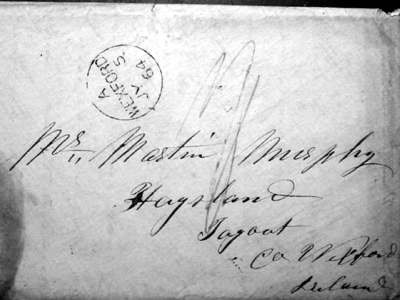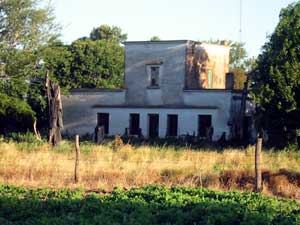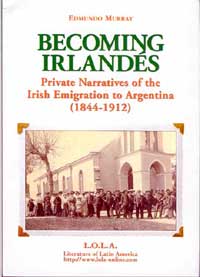This
revised English version of the author’s 2004 Devenir
Irlandés offers some advantages over the original
Spanish edition. It abridges some of the documents that make
up the bulk of the volume: two memoirs and two sets of
family letters from Irish immigrants in Argentina, without
losing any substance. The documents are now presented in
their original language. Murray has also added a fuller
discussion of the notion, conveyed in the title of the book,
that social identities represent processes rather than fixed
entities.
In this
becoming or devenir, Murray identifies three stages
that defy linear concepts of assimilation. Early arrivals
were identified generically as English and seem to have done
little to contest the rubric. Murray’s contention that they
came to “an informal colony of the British Empire in which
everything, except probably meat and hide came from the
British Isles” is — perhaps intentionally — exaggerated.
Fashion and elite culture, from architectural styles to
literary forms, were more likely to originate from
continental Europe than from England. Most immigrants came
from Italy and Spain, as did deeper cultural traits ranging
from language and music to pasta and anarchism. Yet beneath
the hyperbole, there is a valid point. The Irish may not
have exactly evolved “from colonized to colonizers,” but
Argentina’s ethno-racial totem pole supplied new material
for identity construction.
|

Letter from John Murphy (Salto, Buenos
Aires) to Martin Murphy received 5 July 1864
(Anastasia Joyce Collection) |
Being
white, Northern European, and British provided status
building blocks not available to, say, their compatriots in
Liverpool. The label of “backwardness” was pinned at the
time on the native inhabitants of the Pampas rather than on
the newcomers. Catholicism was not a marker of religious and
moral depravity in Buenos Aires. The second stage in this
process of becoming coincides with a surge of cultural
nationalism, bordering on nativism, among
early-twentieth-century Argentine elites. The former
“ingleses” now accentuated their Argentineness: their
connection to the land, to pastoral activities and to the
gaucho (favoured emblems of nationhood), to military,
patriotic rituals, and apparently to Catholicism. Unlike in
most other Latin American countries, Catholicism was a
particular accoutrement of nationalism in Argentina.
Ultimately, they find themselves “becoming irlandés.”
Argentina’s socio-economic decline and Ireland’s rising
fortunes have promoted a revival of what used to be called
in the 1970s “symbolic ethnicity,” that includes conspicuous
St. Patrick’s Day celebrations, decorative shamrocks, and
the replacement of “mate and bizcochitos” with tea and
scones.
A
demographic portrayal of the Irish community is subsequently
offered. Murray calculates that between forty and fifty
thousand Irish came to the River Plate during the century
following 1830. About half of these returned to Ireland or
moved to other countries, particularly the United States;
and about half of those who stayed in Argentina died in
epidemics — a mortality estimate that seems abnormally high.
The county of Westmeath supplied 43 per cent of the exodus,
and Wexford and Longford some 15 percent each. Like
emigrants almost everywhere else, these were young people,
with an average age of twenty-four. Only 15-17% of them
remained in the Argentine capital, probably the lowest urban
concentration among all immigrant groups in the country. The
majority settled in the province of Buenos Aires, with some
later moving to Santa Fe, and engaged predominantly in
pastoral activities. Men outnumbered women three to one
before 1852. One would imagine that the ratio decreased
later because, in general, the female proportion tends to
increase as migration flows mature, and Irish emigration in
general had a higher female ratio than those of most other
contemporary flows. Whatever their gender, few, if any,
spoke Irish as a first language: there is not a single
Gaelic word in the documents other than place names.
|

John Murphy's estancia La Flor del
Uncalito, Salto |
The
documents, of course, may not be entirely representative. As
Murray notes, the family papers that survive tend to be
those that families consider important, normally meaning
that they present the family’s history in a positive light.
Positive or not, the documents here shed much light on the
process of migration from the bottom up. Edward Robbins’
memoirs basically list, chronologically, family events: an
uncle’s military campaign with Simón Bolívar in 1819 and his
death soon after in Bolivia, the building of a farm house
back home, the birth of children and death of parents, the
emigration of thirteen family members to Argentina in 1849,
rural work, business deals and so on. The letters to the
Murphy family in Wexford start from Liverpool in 1844 with
the promise that others would arrive as soon as the ship
docked in Buenos Aires. However the first letter from
Argentina in the volume comes nine years later, perhaps
because early correspondence was not preserved. This
collection is particularly illuminating of the immigrant
experience. It includes requests for pre-paid passages and
remittances, observations about foreigners’ lack of
involvement in local politics, descriptions of the workings
of a sheep farm, news of the Paraguayan War, details about
family feuds and duties, and the assertion that Argentina is
not “a half civilized, half savage desert wilderness such as
we read in Sin-Bad the Sailor and other like fairy tales,”
but a sophisticated country with greater opportunities than
Ireland. The third collection includes letters from three
young women in Buenos Aires to their relative John James
Pettit, who had been born there in 1841, ten years after his
parents had arrived from Ireland, but moved to Australia
with his son in 1852. The last document, as the first, is a
memoir but written much later (in the 1920s), and in a more
literary style, by a third-generation Irish-Argentine who
remembered, among many other delightful tidbits, a creole
gaucho who “spoke English with as good a brogue as any
Irishman." That this writer was born in 1864 and was the
grandson of immigrants highlights the pioneering role that
the Irish - along with the Basques - played in Argentine
immigration and the settling of the Pampas.
This,
however, is not a book written in the hagiographic genre of
“immigrant contributions.” It does not celebrate great deeds
and exceptional accomplishments. It does something more
difficult and intellectually satisfying. It rescues from
obscurity the stories of people who toiled, lived, loved,
and dreamt beyond the spotlight of official histories. These
are stories of everyday life, of home, as Murray’s
interesting discourse analysis demonstrates, rather than
nation. Yet these seemingly mundane narratives are often
more captivating than national epics and, in their
simplicity, at times poetic. Murray’s introduction,
epilogue, and notes place these stories in their broader
historical context and over fifty photographs and
illustrations offer a complimentary visual component to the
text.
José C.
Moya
Barnard College
Department of History
Director, Forum on Migration
Authors'
Reply
I would
like to thank Professor Moya for his thoughtful reading of
my book and for a generous review. When I started working
with the documents of an obscure group of rural settlers in
Argentina, I did not imagine that a leading historian of
migrations in Latin America would be interested in drawing
connections between the cases included in my book and those
of other migrations. There is little with which I disagree
in this review, and I will therefore deliberate further on
some of José's thoughts.
On the
issue of hyperbole, I would like to quote Five Years in
Buenos Ayres 1820-1825 (generally attributed to George
Thomas Love, the editor of the British Packet
newspaper): 'en la ropa del gaucho
- salvo el cuero - todo viene de Inglaterra. Los vestidos de
las chinas salen de los telares de
Manchester. La olla de la comida, las espuelas, los
cuchillos.'
Indeed
this book was published in London in 1825, so the author
refers to that specific period after independence, when
pioneering Irish (and Scottish) sheep farmers were exploring
the southern districts of Buenos Aires province. Perhaps the
metonymy can be extended to the second phase, when the Irish
moved their flocks to the western and northern partidos,
probably up to the fall of Juan Manuel de Rosas in 1852. At
that time, the dominant presence of English-manufactured
products in Argentine every-day life, particularly in the
cities, is unquestionable. Even if overstated, my assertion
points to the remarkable Anglophile society that received
the Irish, especially in the early stages of migration.
The other point is about mortality. I based my estimation on
the number of settlers provided by the thesis (1994) and
articles of Patrick McKenna, who elaborates on Sabato and
Korol's study of 1981. Not only was mortality unusually high
during the 1860s and 1870s due to outbreaks of epidemics -
the letters to John J. Pettit provide tragic examples of the
cholera epidemic of 1868 - but it is also important to note
that numbers of male Irish settlers remained unmarried.
Therefore, the size of the Irish community decreased
significantly owing to return migration, mortality and lack
of offspring.
I would
also like to add here that some of my thinking changed after
the first edition of this book in Spanish was published by
Eudeba. This was not totally unrelated to the human nature
of devenir, but it was also part of my own learning
process in the study of emigrants' identities. Some rather
personal aspects changed radically. For instance, nowadays I
do not seek an Irish passport as I once did, in a somewhat
Romantic fashion, a few years ago. I must acknowledge the
significant influence of the referendum of 11 June 2004,
when an overwhelming majority of the Irish voters denied
jus soli to children born in Ireland of foreign parents.
In contrast, I am currently trying to obtain Colombian
nationality (if the consulates in Bern and Buenos Aires
agree on a less bureaucratic method)! My interest in the
larger, and richer, aspects of the Irish in Latin America
was prompted by a myriad of stories that I found in rare
books or other sources, and that are leading my present
writing.
I wish
to thank Prof. Moya for what is, in overall
terms, a very generous review. To him I am truly indebted.
Edmundo Murray




